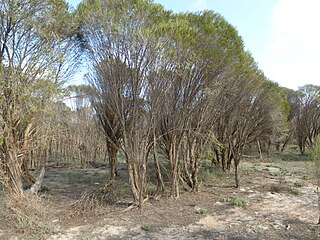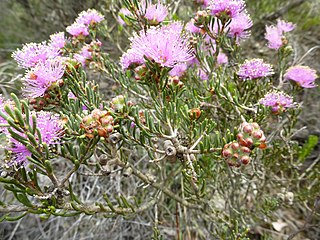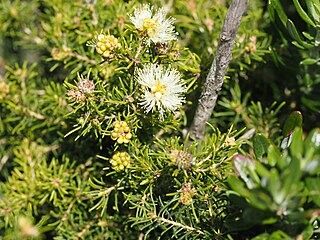
Melaleuca atroviridis is a plant in the myrtle family, Myrtaceae and is endemic to the south-west of Western Australia. It was formerly included in the species Melaleuca uncinata but a review of that species lead to the identification of a number of new species. Like M. uncinata, this species is used for the production of brushwood fencing. It has fewer stamens in the flowers and somewhat smaller clusters of fruit but has the same needle-like leaves with a hooked end and spikes of creamy yellow flowers in early summer.

Melaleuca carrii is a plant in the myrtle family, Myrtaceae and is endemic to the south-west of Western Australia. It is a small shrub similar to Melaleuca pentagona, with "pom-pom" heads of pinkish flowers and sharply pointed leaves but it is generally smaller, lacks a groove in its leaves and retains its petals on the flowers for longer than that species.

Melaleuca calyptroides is a plant in the myrtle family, Myrtaceae and is endemic to the south-west of Western Australia. It is similar to a number of other Western Australian melaleucas such as M. hollidayi with its almost cylindrical leaves, purple pom-pom flower heads and low growth habit but it has longer, wartier leaves and fewer flowers in the inflorescences. The floral cup and woody capsule from which it develops are longer than those of similar melaleucas.Melaleuca calyptroides close.jpg

Melaleuca exuvia is a plant in the myrtle family, Myrtaceae and is endemic to the south of Western Australia. It is easily distinguished by its unusual rough, minni ritchi bark which peels to reveal a new layer of smooth, salmon-pink bark. It is a newly described (2004) species which was formerly included in Melaleuca uncinata.

Melaleuca interioris is a plant in the myrtle family, Myrtaceae and is endemic to Western Australia, South Australia, Queensland, New South Wales and the Northern Territory. It was formerly included in Melaleuca uncinata and is similar to that species with its cylinder-shaped leaves and small heads of yellow flowers, but with smaller, less compressed fruiting capsules.

Melaleuca osullivanii is a plant in the myrtle family, Myrtaceae and is endemic to the south-west of Western Australia. It was first formally described in 2004 after a review of the broombush group, Melaleuca uncinata. It differs from others in the group by having leaves that are fine and circular in cross section. The closest other broombrush is Melaleuca hamata whose leaves are 0.8–1.6 mm (0.03–0.06 in) in diameter compared to 0.7–0.9 mm (0.03–0.04 in) for this species.

Melaleuca sapientes is a plant in the myrtle family, Myrtaceae, endemic to the south-west of Western Australia. It is a small shrub with silky grey leaves and small heads of pinkish flowers in spring or early summer. The attractive, silvery foliage has made this melaleuca a popular garden plant under the incorrect name of Melaleuca holosericea, a similar but much rarer species.

Melaleuca scalena is a plant in the myrtle family, Myrtaceae and is endemic to the south west of Western Australia. Plants of this species were previously included in Melaleuca uncinata or broombush until a review of that species in 2004. Its leaves are narrow cylinders, the flowers in small yellow heads and the fruits tightly packed together in oval clusters. This species is very similar to Melaleuca hamata but the plants have a comparatively scruffy or less strong and healthy appearance.

Melaleuca systena, commonly known as coastal honeymyrtle is a plant in the myrtle family, Myrtaceae and is endemic to the south-west of Western Australia. It was previously known as Melaleuca acerosa. It is a small shrub with crowded foliage and profuse heads of white to yellow flowers on the ends of its branches in spring.

Melaleuca thapsina is a plant in the myrtle family, Myrtaceae and is endemic to the south-west of Western Australia. It is a prickly shrub with fibrous or papery bark, yellow to cream coloured flowers and tightly packed cylinders of fruiting capsules.
Melaleuca villosisepala is a shrub in the myrtle family Myrtaceae and is endemic to the south-west of Western Australia. It is a shrub with narrow leaves, heads of pink to mauve flowers that fade to white and is similar to Melaleuca wonganensis except that its heads of flowers are smaller and pinkish rather than deep purple.

Melaleuca vinnula is a plant in the myrtle family Myrtaceae and is endemic to the south-west of Western Australia. It is a shrub with narrow leaves, heads of white to yellow flowers followed by tight clusters of fruit and it is found in the wheatbelt. It is a newly-described species from a review of the group of melaleucas known as broombrush.

Melaleuca condylosa is a plant in the myrtle family, Myrtaceae and is endemic to the south-west of Western Australia. It is similar to Melaleuca brophyi except that its fruiting clusters are often knobbly and the flower heads and leaves are slightly larger.

Melaleuca marginata is a shrub in the myrtle family, Myrtaceae and is endemic to the south-west of Western Australia. It is distinguished by its prickly leaves and its flowers occurring in long sections of the branches. From 1922 to 2011 was known as Melaleuca coronicarpa.

Melaleuca dichroma is a shrub in the myrtle family, Myrtaceae and is endemic to the south-west of Western Australia. It is unusual for its genus in that its flowers are yellow or creamy-white but age to a pinkish-red.

Melaleuca lateriflora, commonly known as gorada, is a plant in the myrtle family, Myrtaceae and is endemic to the south-west of Western Australia. It is usually an erect shrub with oval leaves and small clusters of white flowers mainly along the older branches.
Melaleuca ochroma is a plant in the myrtle family, Myrtaceae, and is endemic to the south-west of Western Australia. It is very similar to Melaleuca subfalcata, varying mainly in the length of its stamens and styles. Like M. subfalcata, it has pink to mauve flowers and leaves that are very hairy when young but become glabrous when mature.

Melaleuca protrusa is a shrub in the myrtle family, Myrtaceae, and is endemic to the south-west of Western Australia. It is a shrub with papery bark, narrow leaves with a hooked end and cream-coloured or yellow flowers. Although it was described as late as 2010, it is not considered a rare or endangered species. It resembles other members of the brushwood group such as M. uncinata, M. atroviridis and M. zeteticorum.

Melaleuca spectabilis is a plant in the myrtle family, Myrtaceae, and is endemic to the south-west of Western Australia. It was formerly known as a subspecies of Melaleuca longistaminea. It is a low, prickly shrub with yellow or lime-green flowers in spring and early summer.
Melaleuca calcicola is a plant in the myrtle family, Myrtaceae and is endemic to the south of Western Australia. It was formerly known as a subspecies of Melaleuca apodocephala but was reassessed in 2010 and raised to species status. Its branches are corky, the leaves pointed although not prickly and the flowers are creamy white, tipped with yellow.



















